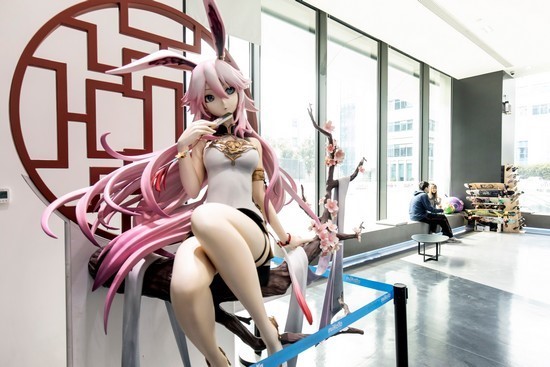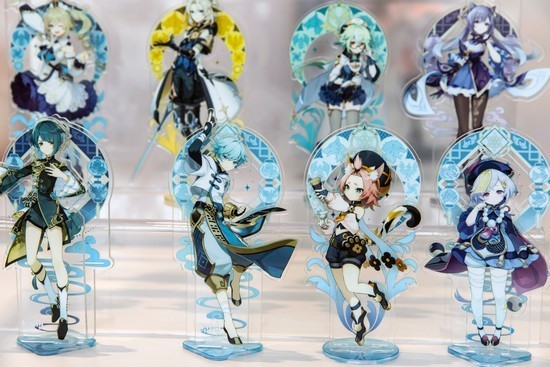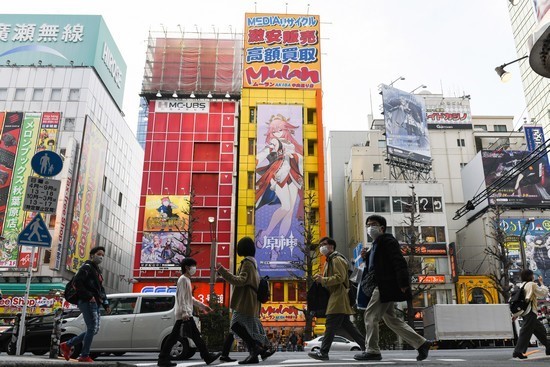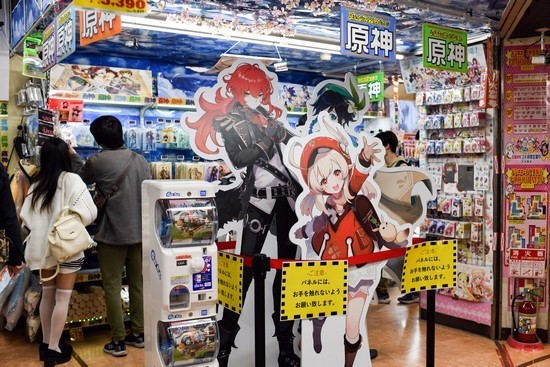Genshin Impact, one of the world’s hottest mobile video games, has all the
characteristics of a
Japanese invention: giant robots; human-size swords;
characters with huge eyes and spiky, rainbow-colored hair; and a puzzling
fixation on women in maid outfits.
اضافة اعلان
There’s just one catch: the game is Chinese.
Released in late 2020, the game is the first bona
fide international smash hit for China’s
video game industry. In its first year
on the market, it raked in $2 billion, a record for mobile games, according to
Sensor Tower, a firm that monitors mobile apps. And, unlike other popular
Chinese games, it is believed to have generated most of its revenue from
overseas.
 A mannequin depicting a video game character at the offices of miHoYo, developer of Genshin Impact, in Shanghai, China, on March 11, 2022.
A mannequin depicting a video game character at the offices of miHoYo, developer of Genshin Impact, in Shanghai, China, on March 11, 2022.
The game’s success points to a shifting balance of
power in the $200 billion-a-year global video game industry, which has long
been dominated by Japan and the US.
Chinese developers, flush with cash from the
country’s vast
domestic market, are looking abroad for growth. They see Japan —
the world’s aging video game superpower — as a ripe target, and Chinese
companies have begun buying up Japanese talent and applying lessons learned
from years of imitating Japan’s industry leaders.
In some respects,
China has already started to
outpace its Asian neighbor. It has built world-class engineering capabilities
over a decade of doing outsourcing work for Japanese video game companies, and
Chinese firms like NetEase and Tencent are making the kinds of investments in
game development that their Japanese competitors can only dream of.
But Genshin Impact is also a reminder that while
China’s video game industry may have achieved technical mastery, it still faces
significant creative shortcomings. Although it has some Chinese elements,
Genshin is a nearly picture-perfect reproduction of one of
Japan’s most popular
video game genres: fantasy role-playing games.
At the Shanghai-based company miHoYo, the game’s
creators proudly refer to themselves as “otaku,” a Japanese term often used to
describe people whose lives are consumed by aspects of Japan’s pop culture,
like manga and anime.
 Figurines depicting characters from the video game Genshin Impact are displayed at the offices of the game’s developer, MiHoYo, in Shanghai, China, on March 11, 2022.
Figurines depicting characters from the video game Genshin Impact are displayed at the offices of the game’s developer, MiHoYo, in Shanghai, China, on March 11, 2022.
The game’s reliance on Japanese motifs is a potent
demonstration of that country’s considerable soft power and the limited returns
on China’s own efforts to build the same. Like the rest of its entertainment
and culture industry, China’s video game sector has struggled to produce
distinctive, original content with international appeal — a symptom, in part,
of its authoritarian government’s tight controls on business and society.
Even as China has grown into an economic goliath, it
has had difficulty shaking the image that it is better at imitating other
people’s ideas than coming up with its own.
Still, copycat or not, Genshin is a sign to many
insiders of the challenges the Japanese video game industry faces. Under fierce
competition from the
US, Europe, and now China, it has ceded its once-dominant
position over the past two decades.
Even many of those who initially dismissed the game
as a cheap knockoff have been won over by its quality and attention to detail.
From the standpoint of technology, art direction, and gameplay, Genshin
represents a huge leap forward for China, said Yukio Futatsugi, chief executive
of Grounding Inc., a game developer in Fukuoka, Japan.
“Frankly, it’s a great game,” he said, adding that
it has made a lot of people in his industry think “we’re in trouble.”
Genshin is notable for its fantasy world-building
and broad appeal across not just countries but also demographics: The game is
unusually popular with women.
 An advertisement for Genshin Impact, a Chinese video game, in the Akihabara district of Tokyo on March 13, 2022.
An advertisement for Genshin Impact, a Chinese video game, in the Akihabara district of Tokyo on March 13, 2022.
There are a large number of female characters among
the dozens that players can use to explore a vast kingdom, delving into
dungeons, battling monsters, and completing quests to advance the story’s epic
narrative about a mysterious traveler entangled in a war between humanity and
the gods.
In what may be a first for China, Genshin’s mythos
has inspired the kind of global response that has long defined success for
Japanese games: cosplay, fan art, and endless online dissections of the
characters and their magical kingdom, Teyvat. (It was the most mentioned game
on Twitter in 2021.)
Players in Japan have mostly seen Genshin as either
an homage to or a knockoff of the newest entry in one of the country’s most
beloved fantasy game franchises: The Legend of Zelda.
Liberal borrowings from the game’s most recent
chapter — called Breath of the Wild — are mixed with a grab bag of references
to other Japanese cartoons and video games, like Hayao Miyazaki’s film “Castle
in the Sky” and the role-playing game Dragon Quest.
MiHoYo overcame initial skepticism among Japanese
players by adding a new area to Genshin, called Inazuma, based on Tokugawa-era
Japan.
The portrayal isn’t
necessarily positive: The country is a cloistered, xenophobic archipelago
clouded in radioactive fog. But for
Japanese players, those negative aspects
have been far outweighed by the positive portrayals of Japan and its video game
culture, said Yusuke Shibata, who runs a YouTube channel where hundreds of
thousands of players watch him play the game.

Japan accounts for nearly one-third of Genshin’s
revenue, even though playtime and downloads have — on mobile at least — lagged
behind those of top homemade games in the country.
Genshin is free to play, but it has generated a
dragon’s hoard of revenue through another concept from Japanese games: charging
players for the chance to win new characters and powerful equipment. The
concept is known as gacha, a Japanese word that describes the country’s beloved
capsule toys.
Players win rewards through a lottery system, and
the odds of getting the best ones — many of which are available only for a
limited time — are vanishingly small. This inducement to gamble has drawn
complaints from both players and regulators in Japan and China, but miHoYo has
allayed those fears by making it entirely possible to play the game without
spending a dime.
It is one of several Chinese games that have broken
through — the others on a smaller scale — in the Japanese market. Only four
years ago, Japanese developers held a monopoly on the top games in Japan, said
Daniel Ahmad, a senior analyst at Niko Partners, a video game research firm.
Now, about one-third of the top 100 mobile games in Japan come from China.
Futatsugi, the Japanese game developer, has been
among the beneficiaries as Chinese companies look overseas. In 2021, he
received a substantial investment from NetEase, giving him more freedom to
express himself artistically.
“There aren’t any companies in Japan that will give
us the money to make the kinds of games we want to make,” he said, adding that
“
Chinese companies are the ones that most recognize our company’s value.”
It doesn’t hurt that he is allowed to keep 100
percent of the intellectual property from the venture.
Futatsugi says the most serious threat to Japan’s video game
industry is not from China. Instead, he locates the core of the problem in
Japan itself, pointing to its aging population and shrinking market, licensing
agreements that keep profits out of creators’ hands, and the reluctance of
conservative companies to embrace new ideas.
Read more Gaming



